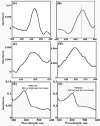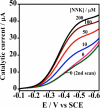Bioelectronic delivery of electrons to cytochrome P450 enzymes
- PMID: 21591685
- PMCID: PMC3128182
- DOI: 10.1021/jp201235m
Bioelectronic delivery of electrons to cytochrome P450 enzymes
Abstract
Cytochrome P450s (cyt P450s) are the major oxidative enzymes in human oxidative metabolism of drugs and xenobiotic chemicals. In nature, the iron heme cyt P450s utilize oxygen and electrons delivered from NADPH by a reductase enzyme to oxidize substrates stereo- and regioselectively. Significant research has been directed toward achieving these events electrochemically. This Feature Article discusses the direct electrochemistry of cyt P450s in thin films and the utilization of such films for electrochemically driven biocatalysis. Maintaining and confirming structural integrity and catalytic activity of cyt P450s in films is an essential feature of these efforts. We highlight here our efforts to elucidate the influence of iron heme spin state and secondary structure of human cyt P450s on voltammetric and biocatalytic properties, using methodologies to quantitatively describe the dynamics of these processes in thin films. We also describe the first cyt P450/reductase films that accurately mimic the natural biocatalytic pathway and show how they can be used with voltammetry to elucidate key mechanistic features. Such bioelectronic cyt P450 systems have high value for future drug development, toxicity screening, fundamental investigations, and chemical synthesis systems.
Figures














Similar articles
-
Electrochemical Activation of the Natural Catalytic Cycle of Cytochrome P450s in Human Liver Microsomes.Electroanalysis. 2012 Nov 1;24(11):2049-2052. doi: 10.1002/elan.201200373. Electroanalysis. 2012. PMID: 23626453 Free PMC article.
-
Efficient bioelectronic actuation of the natural catalytic pathway of human metabolic cytochrome P450s.J Am Chem Soc. 2011 Feb 9;133(5):1459-65. doi: 10.1021/ja108637s. Epub 2011 Jan 7. J Am Chem Soc. 2011. PMID: 21214177 Free PMC article.
-
Control of electrochemical and ferryloxy formation kinetics of cyt P450s in polyion films by heme iron spin state and secondary structure.J Am Chem Soc. 2009 Nov 11;131(44):16215-24. doi: 10.1021/ja9065317. J Am Chem Soc. 2009. PMID: 19886700 Free PMC article.
-
P450BM-3; a tale of two domains--or is it three?Steroids. 1997 Jan;62(1):117-23. doi: 10.1016/s0039-128x(96)00169-9. Steroids. 1997. PMID: 9029725 Review.
-
The cytochromes P450 and b5 and their reductases--promising targets for structural studies by advanced solid-state NMR spectroscopy.Biochim Biophys Acta. 2007 Dec;1768(12):3235-59. doi: 10.1016/j.bbamem.2007.08.007. Epub 2007 Aug 24. Biochim Biophys Acta. 2007. PMID: 17945183 Review.
Cited by
-
Electrochemical Activation of the Natural Catalytic Cycle of Cytochrome P450s in Human Liver Microsomes.Electroanalysis. 2012 Nov 1;24(11):2049-2052. doi: 10.1002/elan.201200373. Electroanalysis. 2012. PMID: 23626453 Free PMC article.
-
Microfluidic electrochemical array for detection of reactive metabolites formed by cytochrome P450 enzymes.Anal Chem. 2011 Dec 15;83(24):9499-506. doi: 10.1021/ac202269t. Epub 2011 Nov 15. Anal Chem. 2011. PMID: 22040095 Free PMC article.
-
Screening reactive metabolites bioactivated by multiple enzyme pathways using a multiplexed microfluidic system.Analyst. 2013 Jan 7;138(1):171-8. doi: 10.1039/c2an35993f. Epub 2012 Oct 25. Analyst. 2013. PMID: 23095952 Free PMC article.
-
Electrochemistry of mammalian cytochrome P450 2B4 indicates tunable thermodynamic parameters in surfactant films.J Inorg Biochem. 2013 Dec;129:30-4. doi: 10.1016/j.jinorgbio.2013.07.039. Epub 2013 Aug 14. J Inorg Biochem. 2013. PMID: 24013063 Free PMC article.
-
Thin multicomponent films for functional enzyme devices and bioreactor particles.Soft Matter. 2014 Nov 7;10(41):8145-56. doi: 10.1039/c4sm01679c. Soft Matter. 2014. PMID: 25209428 Free PMC article. Review.
References
-
- Schenkman JB, Greim H, editors. Cytochrome P450. Springer-Verlag; Berlin: 1993.
-
- Ortiz de Montellano PR, editor. Cytochrome P450. Kluwer/Plenum; New York: 2005.
-
- Kramer JA, Sagartz JE, Morris DL. Nature Rev. Drug Discov. 2007;6:636–649. - PubMed
-
- Sansen S, Yano JK, Reynald RL, Schoch GA, Griffin KJ, Stout CD, Johnson EF. J. Biol. Chem. 2007;282:14348–14355. - PubMed
Publication types
MeSH terms
Substances
Grants and funding
LinkOut - more resources
Full Text Sources

